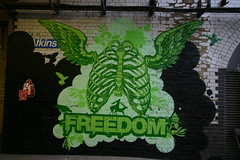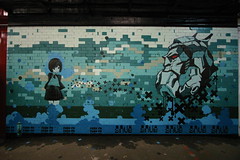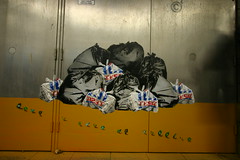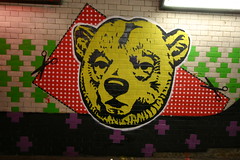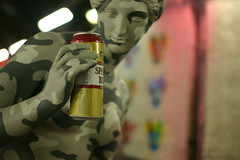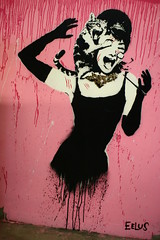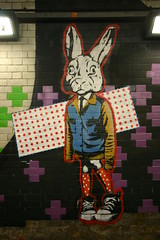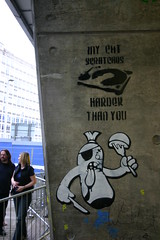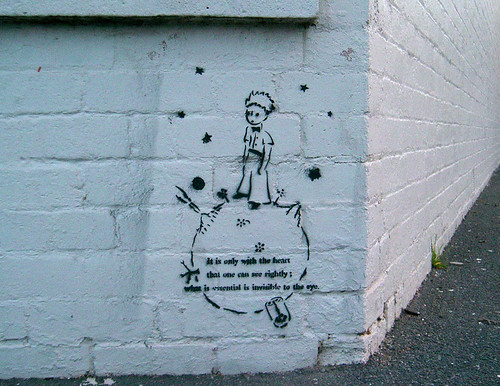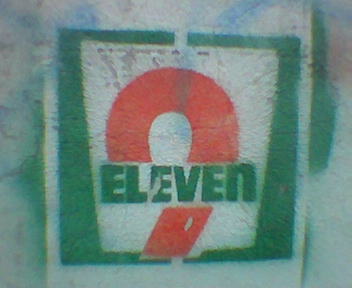The Null Device
Posts matching tags 'street art'
2012/3/13
Art Threat has an article about VOINA, the Russian radical performance-art collective responsible for happenings protesting against the corruption of the Russian state, its abuses of human rights, and the complicity of the mainstream art world. Their projects have included provocations such as sliding live sheep down a pro-Putin election banner at a book fair opening, staging mock hangings of gays and foreigners in Moscow to protest the Mayor's hostile stance to both, spray-painting a giant phallus on a drawbridge opposite the headquarters of the security services in St. Petersburg; though a lot of their ire is also directed at a bourgeois contemporary art world they see as more oriented to catering to the corrupt elites than questioning the state of affairs:
At the Moscow Art Fair in 2007, they staged It’s Time to Whip Russian Art, inviting members of the public to participate in a public flogging of a man dressed in white lying on a white sheet with an S&M whip dipped in red paint, a protest against elitism and conformism in Russian contemporary art.
“All our actions have political underlying messages, but we use art language only. We speak in images, symbols, which are mostly visual. We don’t use the language of political journalism. Politics is just a main theme of our works. In the current socio-political situation in Russia, an honest artist can’t be mute and make glamorous “masterpieces” for oligarchs, who decorate their “brilliant” dachas.”VOINA's actions have, perhaps unsurprisingly, brought the full brunt of the Russian security state down upon them, with all the brutality and arbitrariness that this entails.
“Being captured, the artists with handcuffs on their hands and plastic bags on their heads were thrown into a minibus and were carried from Moscow to St. Petersburg on the iron floor for ten hours. During this trip, cops kicked Oleg, the ideologist of the art group, in the kidneys and head. Two weeks later the human right defenders and the medics, who visited the arrested artists in prison, found hematomas on Oleg’s body in the kidney area and handcuff marks. Leonid had serious bruises.”British street artist turned crypto-celebrity Banksy has offered to pay the bail for Oleg and Leonid (cited as US$133,000), though his offer was rejected. There is a web site which claims to be a defence fund here.
2012/2/4
A French blog named Tout Bon has a gallery of the most interesting street art of 2011 (for varying definitions of "street art"):


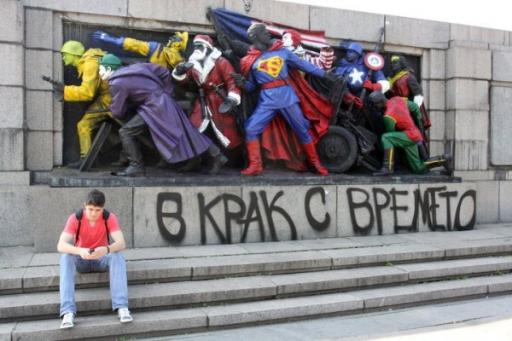
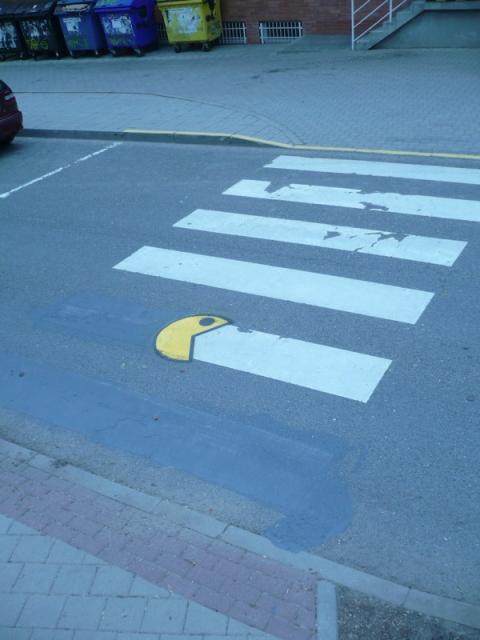
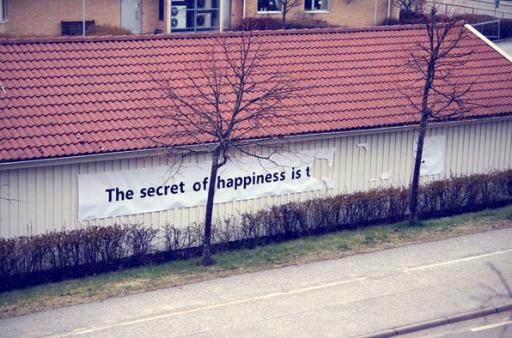
And plenty more...
2011/9/7
The Guardian's art correspondent Jonathan Jones argues that mainstream acceptance is killing street art; how what used to be an outlaw pursuit, charged with an edgy, subversive frisson, is now thoroughly commodified, exhibited in galleries, flogged en masse to tourists and posed alongside by centre-right politicians, fatally eroding what underground credibility it once had:
Visitors to London buy Banksy prints on canvas from street stalls, while in Tripoli photographers latch on to any bloke with a spray can near any wall that's still standing. Graffiti and street art have become instant – and slightly lazy – icons of everything our culture lauds, from youth to rebellion to making a fast buck from art.
Maybe there was a time when painting a wittily satirical or cheekily rude picture or comment on a wall was genuinely disruptive and shocking. That time is gone. Councils still do their bit to keep street art alive by occasionally obliterating it, and so confirming that it has edge. But basically it has been absorbed so deep into the mainstream that old folk who once railed at graffiti in their town are now more likely to have a Banksy book on their shelves than a collection of Giles cartoons.He has a point about the mainstreaming and commodification of once transgressive phenomena (recently we have witnessed the confirmation of punk's position as a safe and cozy part of Britain's heritage by the National Trust releasing a punk compilation album), and the fact that there is a lot of street art which, when one puts aside its illegality and unconventional locations, is quite mediocre. Though the final stage of this process of commodification seems less than apocalyptic: a culture in which street art becomes a sort of accepted folk art, sometimes critical or confrontational, occasionally brilliant, more often mediocre, and very occasionally leading to wealth and fame, though generally practiced by small-time artists, and tolerated by society as part of the local culture and the broader conversation. Which, to me, looks healthier than a society of zero-tolerance policies, where the means of street-level communication belong exclusively to corporate advertisers.
2011/7/15
Web design webzine Smashing Magazine has an interesting article on Berlin's street-art heritage:
After the few East Germans who crossed the Berlin Wall in the ’80s blinked and pinched themselves, what do you think was the first thing they saw? They saw big bubbly letters, spelling out words in German, English and French. They saw political slogans, either carved indelibly into the concrete or sprayed temporarily onto surfaces, commenting not only on the situation in Germany, but on the whole political world: “God Ble$$,” “Concrete Makes You Happy,” “Death to Tyrants.” As far as they could see, covering every inch of wall, was layer upon layer of zest, life and color.
After the collapse of the Berlin Wall, the graffiti artists marched straight into East Germany. Mitte, Friedrichshain, Prenzlauer Berg — all of the areas that the military had occupied became a new playground for the Western artists and became a new world for the Eastern artists who joined them. Few doubted that the East Germans’ work was weightier. It wasn’t that they were better artists, but that they could express — with authority — the one concept close to the hearts of all people now living in the city: what it meant to be free.
The article briefly profiles and analyses the work of a number of Berlin street artists, including XOOOOX (who does impeccably drawn black-and-white stencils of glamorous fashion models, sometimes relieving themselves), Mein Lieber Prost (whose sketches of jolly cartoon homunculi have become immediately recognisable)
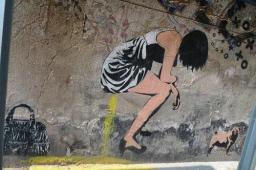
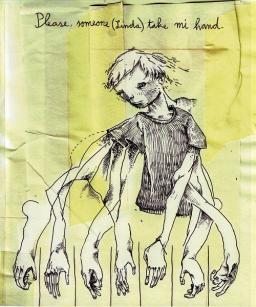 and the curious case of Linda's Ex, an artist who, in 2003, put up hand-drawn posters imploring someone named Linda to take him back, engaging others to debate whether the object of the unknown artist's affections should return to him, before revealing that Linda never existed, and the whole thing was an art project, sort of like a web soap implemented in wheatpaste.
and the curious case of Linda's Ex, an artist who, in 2003, put up hand-drawn posters imploring someone named Linda to take him back, engaging others to debate whether the object of the unknown artist's affections should return to him, before revealing that Linda never existed, and the whole thing was an art project, sort of like a web soap implemented in wheatpaste.
At first, people either ignored the posters or were mildly curious. But as both the pictures and messages increased in intensity, they had no choice but to take notice. On one poster, Linda’s ex told his estranged lover that he would be waiting to speak to her at a certain bar every Saturday and Tuesday night. People were starting to believe that his suffering was real. And if his suffering was real, then they did not doubt that he needed help.
People enjoy XOOOOX’s approach because of his objective treatment of his subjects, presenting each model as neither happy nor sad, neither warm nor cold. He even draws one model urinating on the ground; while some might interpret the piece as a sign of arrogance, XOOOOX’s signature, flowing from her head like a thought bubble, persuades sensitive observers to judge her on a more humane level. She is, he suggests, just like everyone else.The article also mentions the peculiar status of street art in Berlin. Graffiti is, of course, an outlaw activity and subculture, and gets its vitality from its fraught, illegal status. Berlin (the capital of Germany, a country not known for its citizens' cavalier disdain of regulation, no less), however, gets a lot of its buzz (and, indirectly, tourist revenue) from this underground culture. Berlin's police insist that graffiti is a crime, whilst focussing their enforcement efforts on gang-related tagging. Meanwhile, having dodged the threat of prosecution, street art arguably faces the threat of legitimacy, of being turned into just another cultural consumable in a gentrified playground for the affluent:
Today, such work has made the street art a tourist attraction. Kunsthaus Tacheles, once an artists’ squat and still a focal point of the scene, holds disco nights downstairs and sells urban art books upstairs — its bar is as expensive as anywhere in the city. Artists such as XOOOOX, Mein Lieber Prost and Alias have started to exhibit and sell in galleries. They still work on the street, but they are no longer impoverished artists — if they ever were. They can afford to travel and work in countries across the world.
While these artists believe that street art needs to appeal to a wider audience, the local, more traditional artists, such as the tagging crews, disagree. They argue that street art derives its power from being on the margins of society; only from the outside can they address problems within it. That difference of opinion is opening a space in the scene that can be filled only by the mainstream. In the next few years, street art has the potential to become a social movement as inclusive as anything from the ’50s and ’60s.Does it make sense to talk of tagging crews as "artists", though?
2011/6/8
The question of tagging versus graffiti art came up at the trial of London tagger Daniel "Tox" Halpin, whose handiwork will be immediately familiar to many Tube commuters:
The 26-year-old, from Camden, north London, whose masked image and story of anarchism has featured on television documentaries and in magazines, was found guilty of a string of graffiti attacks across England after prosecutor Hugo Lodge told a jury: "He is no Banksy. He doesn't have the artistic skills, so he has to get his tag up as much as possible."
As he was remanded in custody for sentencing, his artistic merit was further questioned by the reformed guerilla graffiti artist turned establishment darling Ben "Eine" Flynn, whose work was presented to the US president, Barack Obama, by the prime minister, David Cameron, last year. "His statement is Tox, Tox, Tox, Tox, over and over again," said Flynn after the trial at Blackfriars crown court, in which he gave evidence as an expert witness. In his opinion, the Tox "tags" or signatures, and "dubs" (the larger, often bubble lettering) were "incredibly basic" and lacking "skill, flair or unique style".While Mr. Tox is not known for his artistic flair, that didn't stop him interrupting his criminal damage career top attempt to surf the post-Banksy hype boom, hoping that someone with more money than sense would interpret his tagging as a particularly "edgy", "real, innit" and "well fucking morocco, yeah?" form of street art and buy it on canvas:
Cashing in on his notoriety, he is said to have made £9,000 in two hours by selling pictures with his Tox tag. Reports in 2009 that he was selling 100 canvasses bearing his notorious mark, at £75 each, precipitated heated debate. Purists condemned him for "selling out", while legal experts mused over whether a loophole made him impervious to the Proceeds of Crime Act.
The appearance of Tox's tag in gilt-framed canvasses was "well funny", Flynn said, adding: "Art is worth what people are prepared to pay for it." People must have bought them as an investment, he added. "I can't imagine they bought them because they actually like them."Halpin's co-defendants include a students of ultra-hip art school Goldsmiths and an Edinburgh Collge of Art graduate; his own credentials are not on record. Halpin and two defendants await sentencing.
2010/5/23
A few quick links to things recently seen:
- A visual study guide to cognitive biases
- Sydney is considering closing George St. to traffic, building a light rail (pronounced "tram") line. Interestingly enough, this plan, like Melbourne's original laneway-driven regeneration and "Copenhagen lanes", was suggested by a Danish urban-planning consultant.
- Google have developed facial recognition technology, capable of identifying individuals in photographs. Given the privacy implications (that plus Google Goggles would be the ultimate stalker tool), they're wisely being very careful about what, if anything, they do with it.
- Spoonflower is a web-based company that will print your designs onto fabric and send it to you. Now if only we could get them talking to Blank Label (a web-based service that lets you design custom shirts, though currently only from a somewhat conservative range of fabrics), then that would be awesome.
- Some music videos: The Pains Of Being Pure At Heart, Higher Than The Stars (warning: features furries), Rainbow Arabia, Holiday In Congo (warning: not actually filmed in Congo but Brazil; features massed Michael Jackson impersonators)
- Nifty trompe l'oeil paste-up on the sides of a fence in Berlin:

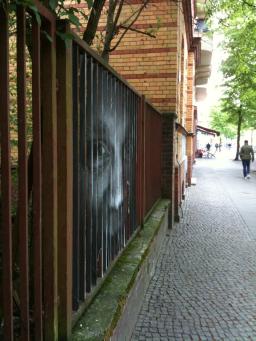
2010/5/8
A chance conversation with a fellow passenger on an overnight train to Copenhagen brought this to my attention: When Copenhagen's central railway station was being renovated a few years ago, the station authorities discovered that two street artists had built a complete apartment in some unused space beneath platform 12. The apartment had apparently survived for four years before being discovered and demolished; the artists, going by the names of ADAMS and ITSO, claim to have built others elsewhere in Copenhagen, and inscribed the story of the house (in neat, professional-looking typography) on the sides of trains.
There were photos of the original house on the web, but they seem to have disappeared beyond the reach of archive.org; however, some can be seen in this video from Danish TV, in which the official who discovered the room is invited to a talk show by a host who seems to know a lot more about the artists in question. The host talks about the room, and then it gets even more interesting; he shows the artists some books, made of cardboard, documenting other such spaces (a shed in the centre of Stockholm, and a room in Berlin beneath Ostbahnhof), and other contrivances (hollowed-out books in the Stockholm Library containing keys to secret spaces; a universal manhole-opening kit in a backpack; a canoe made of recycled advertising billboards, used to explore the sewers beneath Paris). One remarkable thing is the tolerance shown by the official ; he is seen praising the imagination and attention to detail of the artists in a way that, were he in an Anglo-Saxon country, would probably cost him his job. Could this be the legendary Scandinavian pragmatism?
2010/4/29
Melbourne City Council workers have painted over a Banksy rat stencil in Hosier Lane, after the council neglected to tell them that the graffiti in the laneway (famous for its aerosol and stencil art) contained a priceless artwork among the graffiti.
Alexander said the city council would rush through retrospective permits to protect other famous or significant artworks in Australia's second-largest city. "In hindsight, we should have acted sooner to formally approve and protect all known Banksy works," she said.I wonder what's happening there. Have anti-street-art factions seized control of the council and decided to whitewash all of Hosier Lane as a declaration of a Rudy Giuliani-style zero-tolerance policy? What would they have done had they known that the works of an internationally renowned (and valuable) artist were there? Would we have seen the bizarre spectacle of a white-painted laneway with a solitary Banksy rat in one corner? Of course, one of the quickest ways to condemn street art in Melbourne is to bless it with the imprimatur of official approval; Australian graffiti artists are, by and large, larrikins who have only contempt for the approval of officialdom:
Vandals created another outcry in 2008 when they poured paint over the artist's stencil of a diver in an old-fashioned helmet and wearing a trenchcoat. That work was afterwards protected by a sheet of clear perspex, although vandals struck again and poured silver paint behind the barrier, tagging it with the words "Banksy woz ere."
2010/2/7
From a Guardian piece on Massive Attack's artwork, this interesting fact:
"We can't use any of the Heligoland artwork I've painted for the posters on London Underground. They won't allow anything on the tube that looks like 'street art'. They want us to remove all drips and fuzz from it so it doesn't look like it's been spray-painted, which is fucking ridiculous. It's the most absurd censorship I've ever seen. "
2009/2/9
Shepard Fairey, the street artist who created the iconic Barack Obama "Hope" poster, has been arrested in Boston for graffiti he allegedly put up many years ago, on the way to his first solo exhibition at the Institute of Contemporary Art. Break the law here, the message seems to be, and, sooner or later, the law will get you, regardless of your stature.
I wonder if he can get a Presidential pardon.
2008/5/6
This weekend, your humble correspondent went to the Cans Festival, a huge stencil art exhibition in a tunnel under the former Eurostar platforms of Waterloo Station. The festival organisers took the entire road tunnel and transformed it into a gallery, with artists from all over the world painting pieces (most involving stencilling, though a few being paste-ups) along its length. The most publicised name attached to the exhibition was, of course, Banksy, and he had a number of works there; as well as some stencils, he was responsible for a sitting-room installation with derelict sofas and an old piano made available to the public and a number of "remixed" classical statues. Though there were several dozen more artists, and indeed, anyone could come along, register and add their artwork to the exhibition. (On Saturday evening, a section of the passageway was sealed off from the general public and made available only to registered artists, who were busily adorning it with stencils.)
Anyway, here are a few photos; the entire set is here:
2006/10/28
TIBET is the nom de guerre of a Swedish underground artist, in the literal sense. His art involves making 11"-tall statues out of concrete, taking them into tunnels beneath Stockholm and gluing, welding or drilling them into the solid rock. Of course, very few people will actually see them down there, though given that they're going to be around for a long time, eventually someone might.
2006/6/22
Guerilla artist Banksy's latest effort: a piece on the wall of a building in Bristol, depicting a naked adulterer hanging from a window ledge by his fingers whilst the cuckolded husband searches for him.
The Bristol City Council, whose offices overlook the unsolicited artwork, is taking an uncommonly enlightened approach to it: rather than automatically obliterating it and citing Giuliani and the broken-windows theory of public order as justification, it is asking the public whether it is art or vandalism.
2006/3/25
In response to the Melbourne City Council's vandalism policy (interpret that how you will), a coalition of troublemakers has convened the Melbourne Graffiti Games:
In response to this, and the Victorian Governments decision to waste $1 million dollars of tax-payers money in setting up an anti-graffiti taskforce, GGOC have announced the commencement of the 2006 Graffiti Games. During the Graffiti Games, which begin next week and end in April 2006, the entire Central Business District has been declared a maximum tolerance zone open to street art of all forms.Unlike the elitist Commonwealth Games the Graffiti Games will be open to anyone with a spray-can and a good or bad idea. The entire population of Victoria, as well as interstate and international visitors, are encouraged to compete. Although all who take part, and the public at large, will be winners in this tournament the Graffiti Games Organising Committee will also be awarding Gold, Silver and Bronze medals to the most popular entrants in various categories.
These will include -This is a classically Australian response to heavy-handed authority, and anyone who says otherwise needs to read a copy of How To Make Trouble And Influence People.
- Most Elaborate Stencil Piece
- Funniest Slogan
- Largest Graffiti Piece
- Most Daring Placement
- Best Caricature of the Mayor or other City Of Melbourne Councillor
- Most Seditious Piece
2006/3/24
In today's Grauniad, Banksy writes about the war on street art in Melbourne:
"The Melbourne scene is incredibly diverse," says Alison Young, head of the department of criminology at Melbourne University. "The range of artists includes people in their 40s, in their teens and a relatively large number of women." Young was commissioned by the city council to draw up a draft graffiti strategy last March in which she recommended tolerance zones be set up where street art and graffiti be allowed a small space within the city, where writers and artists would be at a lower risk of being arrested. "This was rejected by the city council, despite it generating lots of public support and despite evidence being presented that zero tolerance, for lots of reasons, wouldn't work."
Instead, the council doubled its anti-graffiti budget. "The clean-up is an imposition of a supposedly mainstream, or dominant, cultural view," says Young, "in denial of the diversity of cultural styles that actually exist within a city space."Evidence of Melbourne's stencil-art scene survives online in photographs on websites:
The street art destroyed in Melbourne will survive on graffiti's new best friend - the internet. The web has done wonders for graffiti; it perfectly reflects its transient nature, and graffiti is ludicrously overrepresented on its pages. The ability to photograph a street piece that may last for only a few days and bounce it round the world to an audience of millions has dramatically improved its currency. On the other hand, the internet is turning graffiti into an increasingly virtual pastime. It is now possible to achieve notoriety by painting elaborate pieces in secluded locations, without the associated risk of arrest that is usually attached. By posting photographs online you can become a significant graffiti writer from a town where none of your work is actually visible.Though, given that the Australian government has just banned a video game simulating the writing of graffiti, and is planning a national internet censorship firewall, how much would you want to bet that graffiti-related websites would be viewable unfiltered from within Australia?
And as Melbourne has been Giulianified into inoffensive blandness and approved commercial messages, due largely to the Commonwealth Marketing Exercise, er, Games, London (with a far bigger commercial extravaganza coming to its artist-infested East End in 2012) is likely to be next:
The precedent set by Melbourne does not bode well for London in the build-up to the 2012 Olympics. The games will be set in east London, where Hackney is one of the few remaining parts of the city where affordable studio space for artists still exists. After the warehouses have been flattened by compulsory purchase orders, the pots of grey paint will be opened and an area rich in street culture and frontier spirit will disappear. Factory doors whose flaked layers of Hammerite reveal history like the rings in a tree stump will be thrown on the fire. Disused cranes perched on top of foundries like skeletal crows will be torn down. Everything will be replaced by a cardboard-partitioned village perched on a pile of cheap laminate flooring. And if you think the graffiti will be removed so it can be replaced by vistas of clean urban space, think again. Every meaningful spot will be clogged with giant billboards by the likes of McDonald's encouraging you to get fit by staying at home and watching the games on TV.
2006/1/15
The Melbourne City Council has declared war on the city's status as a stencil-art capital with their new zero-tolerance graffiti plan. Under the plan, building owners will be legally obliged to either remove graffiti (which includes aerosol art or stencil art) or put in applications for each individual piece to remain. And so, the city becomes a little more like Singapore or Giuliani's New York.
2005/12/5
In an attempt to generate spin for the PlayStation Portable, Sony hire graffiti/paste-up artists to put up pictures of kids playing with PSPs as if they were traditional toys. Local hipsters, irritated with the Spectacle's commodification of dissent (and/or copy-protection malware on Sony CDs), retaliate, scrawling anti-Sony slogans on them. Discussion ensues:
"Aaaaaarrrrggggghhh. I KNEW something wasn't right about the thing when I took a picture of it a couple weeks ago in san Francisco. Two kids. 6-feet tall. Right near the new freeway off-ramp. Looked way too clean to be real. Working for a branding firm. I'm adamantly opposed to this kind of infiltration by the big corporations. Equivalent in my mind with viral marketing stealth efforts to generate a buzz about a new product the unsuspecting masses by some cool, attractive shill on the company payroll."And more pictures here.
Here is a gallery of stencil art from Buenos Aires. Much of it is fairly political, and not too dissimilar in spirit to Australian stencil art.
2005/12/3
A newly released book has dubbed Melbourne the stencil art capital of the world:
London's street art guru Tristan Manco, whose books include Stencil Graffiti and Street Logos, vouches for the vigour of Melbourne's stencil art scene — with one qualification. "To take on the title of 'best stencil graffiti scene in the world', Melbourne would have to have a showdown with Buenos Aires in Argentina — the scene there has reached critical mass right now, with a fiery political and creative passion."This title could be short-lived, though, with the Melbourne City Council and Victorian government adopting a Giuliani-esque zero-tolerance policy towards graffiti, in order to sanitise Melbourne for the Commonwealth Games, as well as the new sedition laws allowing more severe penalties for some political statements (the one of Philip Ruddock's head with "Insert Bullet Here", for example). Though, as some say, the hard-line zero-tolerance approach could backfire, by replacing Melbourne's characteristic stencil art with ugly, mindless tagging
But the State Government and Melbourne City Council's hardline approach to graffiti will backfire, according to Smallman and the stencil artists and result in a proliferation of one of the most detested forms of graffiti — tagging, which can be done in five to 10 seconds.
2005/10/20
2004/12/29
French underground artist Invader, who's responsible for putting up those space-invader tiles in cities around the world (there's one in Covent Garden in London, and I believe I saw some in Melbourne as well), has now released an exclusive line of sneakers. €103 gets you a pair which leave a footprint with a space-invader graphic. The sneakers are a limited edition of 1,500 pairs. No word on whether or not they are made by children in sweatshops.
Maybe next we'll see Heavy Product Blundstone boots with a motif of a man struggling with a bucket on the sole.
2004/9/18
This anthropomorphic food mascot, seen in Southborough, Kent, looks like it has an acute anxiety disorder.

London's answer to Victor Lancaster (i.e., the plastic bucket drummer guy in Melbourne):

I wonder what the penguinistas have to say about this:
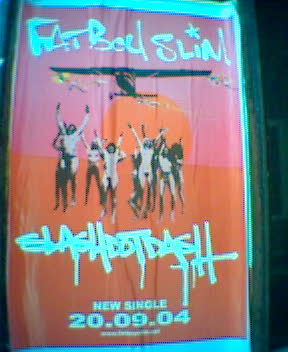
Seen near Brick Lane, Spitalfields:
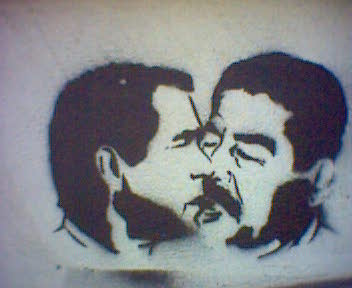
And a follow-up to an earlier post:
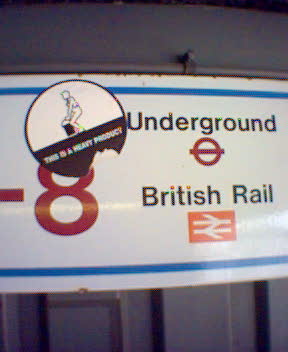
2004/6/28
The next trend in graffiti, after aerosol art, stencil art and pasted-on designs, involves selectively cleaning grimy walls. It's much like stencil art, only rather than applying aerosol paint, the artist uses solvent and scrubs a shaped area of the wall clean, creating a distinct image. And, led by the apparent legality of cleaning public surfaces, guerilla advertisers are getting onboard; some chap in Leeds named "Moose" has been commissioned by Diageo to advertise Smirnoff vodka in this fashion. The Leeds City Council, however, doesn't quite see it that way.
2004/6/23
2004/6/5
This evening, I caught a train to North Coburg, getting off at Batman station (yes, to the Americans in the audience, we do name our railway stations after superheroes here, because we Australians are weird), and walking through darkened streets, with the occasional desultory-looking art-decoish bungalow that has seen much better days, looking for an art gallery located at 8 Lyon St. After considerable walking through this wasteland, I started wondering "what sort of art gallery would set up here?". Eventually, I found it, in a former factory/mechanic's shop/similar, across the road from the only other sign of life in the neighbourhood, a bikie clubhouse (the Foolish Few Motorcycle Club, I believe), some of whose members mingled with the hip young artists and miscellaneous troublemakers.
The art varied; it was mostly "underground" art of various sorts (think "ooh, am I OFFENDING your BOURGEOIS SENSIBILITIES? Good. *Fuck* *you*, SUBURBAN YUPPIE PIG!"). A lot of stencil art (some very intricate), done on old car doors, some of that homie graf/stencil/sticker hybrid stuff that's going up all over the city (there was one piece by "Monkey" and someone else, depicting a fantastic world, with their tags all over everything; got to love the hip-hop culture's tendency towards self-mythologisation), underground comics from members of Silent Army, someone's set of nude drawings of female artists (done as a set of postcards, yours for $10), and underworld hitman-turned-artistic cause celebre Chopper Read's own paintings, showing crude figures of big-breasted women with Ned Kelly helmets (alas, I'm not sufficiently well-versed in contemporary art to tell whether Chopper's art is a work of postmodern genre-crossing genius, a curiosity of "outsider art" notable more for who made it than its own virtues, or a publicity stunt). Chopper didn't seem to be there, though there were quite a few bikies with short-cropped hair, tattoos, big bushy beards and, in one case, Nazi patches. Which, I suppose, made the whole thing a lot more edgy and hardcore and "keeping it real". Oh, and Cameron Potts was there, in his "Osama Bin Laden World Hero" T-shirt. Meanwhile, a band (consisting of members of Jihad Against America and/or The Eggs, I'm told) made noises with distorted guitars and a theremin.
Many of the artworks had prices that wouldn't leave much change from a grand. I wonder whether many well-heeled collectors will trek out in their BMWs to the industrial wasteland to pick up a stencilled car door for their open-plan loft in St Kilda or wherever.
2004/2/29
Sunday Photo Feature #03: decoration on traffic-light control boxes in Melbourne, Sydney and Brisbane, 2003:
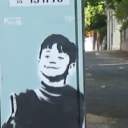
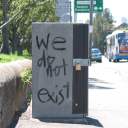
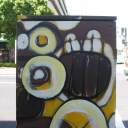
2002/8/12
2000/11/24
